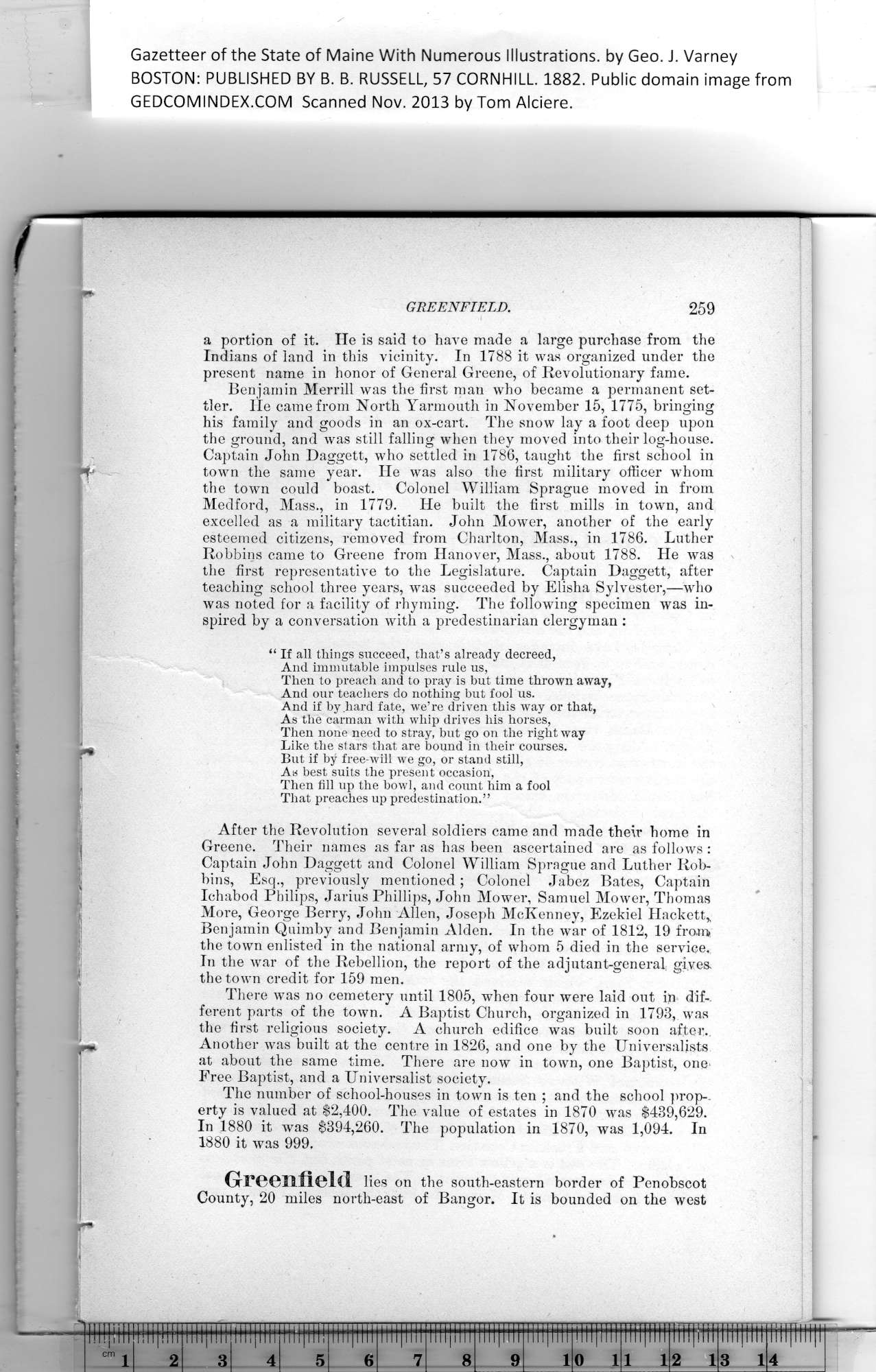|
Gazetteer of the State of Maine With Numerous Illustrations, by Geo. J. Varney
BOSTON: PUBLISHED BY B. B. RUSSELL, 57 CORNHILL. 1882. Public domain image from
GREENFIELD. 259
a portion of it. He is said to have made a large purchase from the
Indians of land in this vicinity. In 1788 it was organized under the
present name in honor of General Greene, of Revolutionary fame.
Benjamin Merrill was the first man who became a permanent set-
tler. He came from North Yarmouth in November 15, 1775, bringing
his family and goods in an ox-cart. The snow lay a foot deep upon
the ground, and was still falling when they moved into their log-house.
Captain John Daggett, who settled in 1786, taught the first school in
town the same year. He was also the first military officer whom
the town could boast. Colonel William Sprague moved in from
Medford, Mass., in 1779. He built the first mills in town, and
excelled as a military tactitian. John Mower, another of the early
esteemed citizens, removed from Charlton, Mass., in 1786. Luther
Robbins came to Greene from Hanover, Mass., about 1788. He was
the first representative to the Legislature. Captain Daggett, after
teaching school three years, was succeeded by Elisha Sylvester,—who
was noted for a facility of rhyming. The following specimen was in-
spired by a conversation with a predestinarian clergyman :
“ If all things siicceed, that’s already decreed,
And immutable impulses rule us,
Then to preach and to pray is but time thrown away,
And our teachers do nothing but fool us.
And if by hard fate, we’re driven this way or that,
As the carman with whip drives his horses,
Then none need to stray, but go on the right way
Like the stars that are bound in their courses.
But if by free-will we go, or stand still,
As best suits the present occasion,
Then fill up the bowl, and count him a fool
That preaches up predestination.”
After the Revolution several soldiers came and made their home in
Greene. Their names as far as has been ascertained are as follows :
Captain John Daggett and Colonel William Sprague and Luther Rob-
bins, Esq., previously mentioned; Colonel Jabez Bates, Captain
Ichabod Philips, Jarius Phillips, John Mower, Samuel Mower, Thomas
More, George Berry, John Allen, Joseph McKenney, Ezekiel Hackett,
Benjamin Quimby and Benjamin Alden. In the war of 1812, 19 from,
the town enlisted in the national army, of whom 5 died in the service.
In the war of the Rebellion, the report of the adjutant-general gives,
the town credit for 159 men.
There was no cemetery until 1805, when four were laid out in dif-
ferent parts of the town. A Baptist Church, organized in 1793, was
the first religious society. A church edifice was built soon after.
Another was built at the centre in 1826, and one by the Universaljsts
at about the same time. There are now in town, one Baptist, one-
Free Baptist, and a Universalist society.
The number of school-houses in town is ten ; and the school prop-,
erty is valued at $2,400. The value of estates in 1870 was $439,629.
In 1880 it was $394,260. The population in 1870, was 1,094. In
1880 it was 999.
Greenfield lies on the south-eastern border of Penobscot
County, 20 miles north-east of Bangor. It is bounded on the west
PREVIOUS PAGE ... NEXT PAGE
This page was written in HTML using a program written in Python 3.2
|
